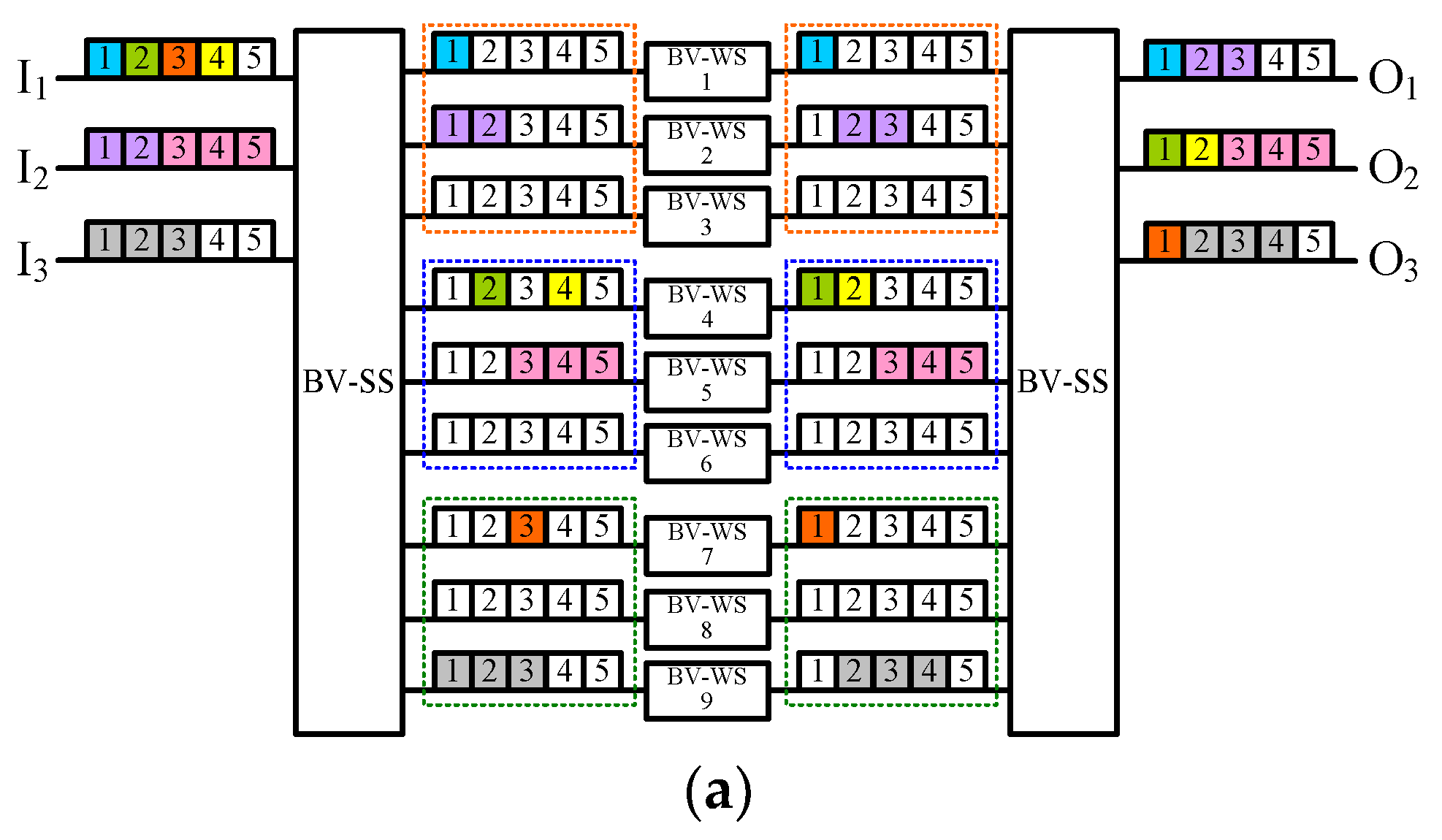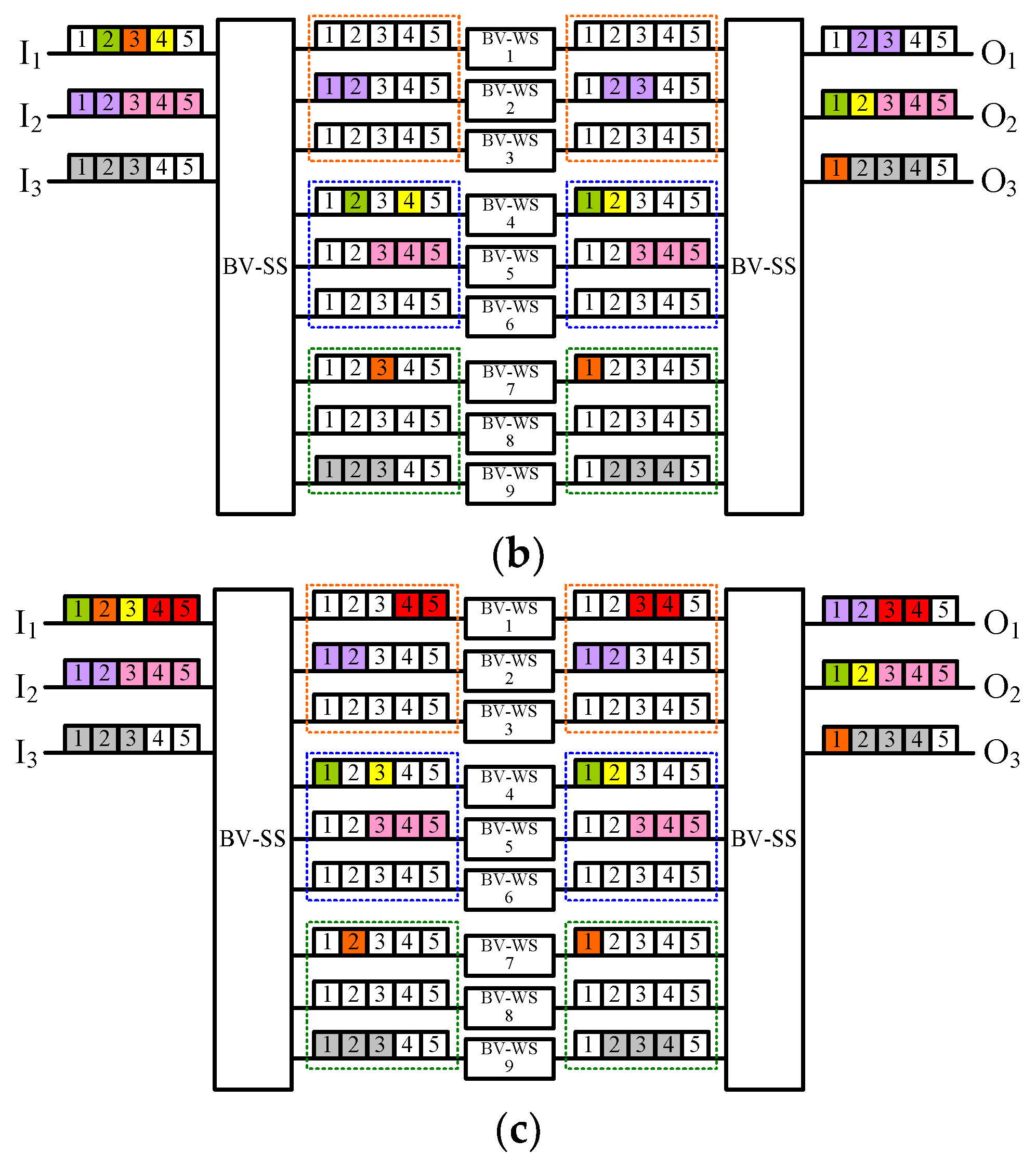Rearrangeable and Repackable S-W-S Elastic Optical Networks for Connections with Limited Bandwidths
Abstract
1. Introduction
2. Preliminaries
3. Rearrangeable Nonblocking (RNB) SWS1(q, p, n) Switching Fabrics with mmax = 1
4. RNB and RPNB SWS1(q, p, n) Switching Fabrics with 2 ≤ mmax ≤ n
4.1. RNB SWS1(q, p, n) switching fabrics with 2 ≤ mmax ≤ n
- Routing Algorithm 2 (for Arrivals):
- Step 1: (i, j, m) is routed in the leftmost m adjacent available FSUs of Ii and the same FSUs of I′q⋅(j−1)+i.
- Step 2: (i, j, m) is routed in the leftmost m adjacent available FSUs of Oj and the same FSUs of O′q⋅(j−1)+i.
- Routing Algorithm 2 (for Rearrangements):
- Step 1: All connections held in Ii, that is, (i, j′, m) for 1 ≤ j′ ≤ q, are rearranged to the leftmost m adjacent available FSUs of Ii and the same FSUs of I′q⋅(j′−1)+i.
- Step 2: All connections held in Oj, that is, (i′, j, m) for 1 ≤ i′ ≤ q, are rearranged to the leftmost m adjacent available FSUs of Oj and the same FSUs of O′q⋅(j−1)+i′.
4.2. RPNB SWS1(q, p, n) Switching Fabrics with 2 ≤ mmax ≤ n
5. Conclusions
Funding
Conflicts of Interest
References
- Jinno, M.; Takara, H.; Kozicki, B.; Tsukishima, Y.; Sone, Y.; Matsuoka, S. Spectrum-efficient and scalable elastic optical path network: Architecture, benefits, and enabling technologies. IEEE Commun. Mag. 2009, 47, 66–73. [Google Scholar] [CrossRef]
- Gerstel, O.; Jinno, M.; Lord, A.; Yoo, S.J.B. Elastic optical networking: A new dawn for the optical layer? IEEE Commun. Mag. 2012, 50, S12–S20. [Google Scholar] [CrossRef]
- Tomkos, I.; Azodolmolky, S.; Sole-Pareta, J.; Careglio, D.; Palkopoulou, E. A tutorial on the flexible optical networking paradigm: State of the art, trends, and research challenges. Proc. IEEE 2014, 102, 1317–1337. [Google Scholar] [CrossRef]
- Spectral Grids for WDM Applications: DWDM Frequency Grid. In ITU-T Standard G.694.1; International Telecommunications Union (CCIR) and (CCITT): Geneva, Switzerland, 2012.
- Zhang, P.; Li, J.; Guo, B.; He, Y.; Chen, Z.; Wu, H. Comparison of node architectures for elastic optical networks with waveband conversion. China Commun. 2013, 10, 77–87. [Google Scholar]
- Chen, Y.; Li, J.; Zhu, P.; Niu, L.; Xu, Y.; Xie, X.; He, Y.; Chen, Z. Demonstration of Petabit scalable optical switching with subband-accessibility for elastic optical networks. In Proceedings of the 2014 OptoElectronics and Communication Conference and Australian Conference on Optical Fibre Technology C, Melbourne, Vic, Australia, 6–10 July 2014. [Google Scholar]
- Danilewicz, G.; Kabaciński, W.; Rajewski, R. Strict-sense nonblocking space-wavelength-space switching fabrics for elastic optical network nodes. J. Opt. Commun. Netw. 2016, 8, 745–756. [Google Scholar] [CrossRef]
- Kabaciński, W.; Michalski, M.; Rajewski, R. The strict-sense nonblocking W-S-W node architectures for elastic optical switch. J. Lightwave Technol. 2016, 34, 3155–3162. [Google Scholar] [CrossRef]
- Kabaciński, W.; Michalski, M.; Abdulsahib, M. The strict-sense nonblocking elastic optical switch. In Proceedings of the 2015 IEEE 16th International Conference on High Performance Switching and Routing (HPSR), Budapest, Hungary, 1–4 July 2015. [Google Scholar]
- Kabaci’nski, W.; Michalski, M.; Abdulsahib, M. Wide-sense nonblocking elastic optical switch. Opt. Switch. Netw. 2016, 25, 71–79. [Google Scholar] [CrossRef]
- Kabaciński, W.; Rajewski, R.; AI-Tameemi, A. Simultaneous connections routing in W-S-W elastic optical switches with limited number of connection rates. In Proceedings of the 2017 International Conference on Optical Network Design and Modeling (ONDM), Budapest, Hungary, 15–18 May 2017. [Google Scholar]
- Lin, B.-C. Rearrangeable W-S-W elastic optical networks generated by graph approaches. J. Opt. Commun. Netw. 2018, 10, 675–685. [Google Scholar] [CrossRef]
- Yoo, S.J.B. Integrated photonic-electronic technologies for next generation data centers and the future internet. In Proceedings of the 2012 International Conference on Photonics in Switching (PS), Ajaccio, France, 11–14 September 2012. [Google Scholar]
- Clos, C. A study of non-blocking switching networks. Bell Syst. Tech. J. 1953, 32, 406–424. [Google Scholar] [CrossRef]
- Hwang, F. The Mathematical Theory of Nonblocking Switching Networks; World Scientific: Singapore, 2004. [Google Scholar]
- Jajszczyk, A.; Jekel, G. A new concept-repackable networks. IEEE Trans. Commun. 1993, 41, 1232–1237. [Google Scholar] [CrossRef]
- Jajszczyk, A. Nonblocking, repackable, and rearrangeable Clos networks: Fifty years of the theory evolution. IEEE Commun. Mag. 2003, 41, 28–33. [Google Scholar] [CrossRef]
- Chakrabarty, A.; Collier, M. Efficient Implementation of Symmetric Multistage Repackable Networks. In Proceedings of the 2010 International Conference on Computational Intelligence and Communication Networks, Bhopal, India, 26–28 November 2010. [Google Scholar]
- Lin, B.-C.; Lea, C.-T. Repackable multi-log2N networks. Theor. Comput. Sci. 2016, 609, 22–31. [Google Scholar] [CrossRef]
- West, D.B. Introduction to Graph Theory; Pearson: New York City, NY, USA, 2001. [Google Scholar]




© 2020 by the author. Licensee MDPI, Basel, Switzerland. This article is an open access article distributed under the terms and conditions of the Creative Commons Attribution (CC BY) license (http://creativecommons.org/licenses/by/4.0/).
Share and Cite
Lin, B.-C. Rearrangeable and Repackable S-W-S Elastic Optical Networks for Connections with Limited Bandwidths. Appl. Sci. 2020, 10, 1251. https://doi.org/10.3390/app10041251
Lin B-C. Rearrangeable and Repackable S-W-S Elastic Optical Networks for Connections with Limited Bandwidths. Applied Sciences. 2020; 10(4):1251. https://doi.org/10.3390/app10041251
Chicago/Turabian StyleLin, Bey-Chi. 2020. "Rearrangeable and Repackable S-W-S Elastic Optical Networks for Connections with Limited Bandwidths" Applied Sciences 10, no. 4: 1251. https://doi.org/10.3390/app10041251
APA StyleLin, B.-C. (2020). Rearrangeable and Repackable S-W-S Elastic Optical Networks for Connections with Limited Bandwidths. Applied Sciences, 10(4), 1251. https://doi.org/10.3390/app10041251




